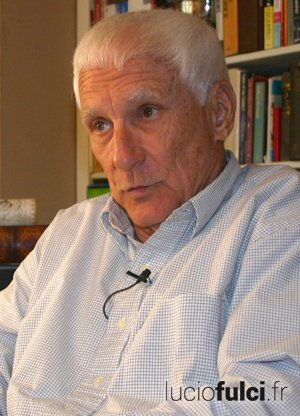
Larry Ray – actor/assistant to the producer (The Beyond)
The Beyond is without a doubt Fulci’s most famous and appreciated work. A vast number of iconic images are remembered from it : the painter’s hanging, the mysterious symbol, Emily on the deserted Pontchartrain Causeway as well as the forever beautiful final sequence.
Numerous analysis and often over-interpretations have their consequences of this fame. The film’s shooting has been discussed many times by Fulci himself but also by his production team and actors over the past ten years. But until now, the American point of view on the making of the movie has been almost completely neglected. Here is an interview with Larry Ray, an American broadcast journalist and actor whom ended up being an assistant to the producer during the making of the film after being asked to act as translator for a few days of early scouting in New Orleans…
How did you end up being part of the shooting team of The Beyond?
I had just ended up a 20 year career as a TV journalist and feature producer in New Orleans, and was about to create my own video production company, TELEventure, so I was available. That’s when Jo Beth Bolton, The Louisiana State Film Commissioner, called me telling me an Italian production wanted to scout locations in the area. Their problem was that none of them spoke much English. As I am bilingual and know Louisiana real well, she thought I could help. I first met Fabrizio De Angelis, the producer, who was a real gentleman and I then helped Sergio Salvati and Lucio Fulci to find suitable shooting locations. I did all this without ever reading a single line of the script. We got along very well, they liked me and asked if I could work full time on the film in the USA.
What job were you actually doing?
I became assistant to the producer. I dealt with anything possible and imaginable. I was finding extras, looking after the money coming from Italy, serving as translator with local authorities, and so on. This is all due to the fact that the budget was ridiculously tight… Like any producer worthy of his title, De Angelis was a juggler. I also worked very closely with David Pash, the production director, an amazing guy.
What were the different shooting locations?
The whole cast and crew had rooms at the International Hotel which was on Canal Street, in the centre of New Orleans. The very nice hotel belonged to the sons of Italian immigrants from Sicily. The new members of the cast who were in town just for a day or two were also stayed there. Lots of the exterior shooting, whether day or night, was done in the French Quarter also called “Le Vieux Carré”. We also shot on Orange Street in a historical part of the town for the scene of the boarded-up house as well as on the campus of Dillard University. We used the main administration building with its large columns for the exterior of the hospital where Warbeck drives up and enters. Opposite the French Quarter, we shot in the historical St. Louis Cemetery #1. Because the town and more precisely “Le Vieux Carré” is built on reclaimed land on top of ancient swamps, coffins tend to resurface after heavy rains. So all burials werre done in brick vaults above ground. We recruited the young priest of a nearby catholic church for the burial scene.
What about the Hotel?
So the shooting then went to Lake Pontchartrain, near Madisonville in Louisiana, on the grounds of the Fairview Riverside State Park where the historic Otis House is located. This means that the actors and the technical team had to drive more than 77 kms round trip to go to and from work daily from New Orleans. There were four or five vans for transportation. I hired the caterers for the shoot in the town centre and different ones when we were working in the Otis House.
We know about the Italian film crew working on the shoot, but what about any American crew?
New Orleans independent producer, Joe Catalanotto was hired at the last minute after the film he was about to start working on was abruptly cancelled. It was a low budget horror film originally entitled “The Scream.” We were able to get him and his team which was great for them and also for Fulvia Film. Joe was a legend and owned a huge rental inventory of vans, lights, generators and all other useful gear for the shoot. “Little Joe” was already well established and renowned on the West Coast and New York, not only for his production equipment but also for his work with low cost and small production teams. He was a man full of energy and always busy. The Italians loved him as he was from Italian origin and had a great sense of humour on top of being a consummate professional. He knew how to find electrical power anywhere even sometimes under very dangerous conditions.
I imagine that you didn’t know Lucio Fulci before working on The Beyond. What was your relationship with him like?
You are right, I didn’t know him. I have to say that I had really good moments with him. Nevertheless he was quite mysterious, moody.
What do you mean?
He sometimes yelled during the shoot but he knew how far he could push it as he knew his crew and actors real well. They had done several movies together. Fulci needed to mark his territory. I remember that while setting up for the scene in the old boarded-up house he had a tantrum because he wanted some ice cream We sent somebody to buy him some. The lights were set, the actors ready but Fulci refused to shoot until he had his ice cream. The makeup was starting to run in the steamy New Orleans heat.. His ice cream finally arrived and he ultimately blamed the errand boy for the delay. In fact, Fulci was like a child, he loved to shout non stop “Action ! Action !” and when an idea popped into his mind he would say “Hey, let’s try this”.
On the Art level, how was it going?
The early concept script outline was only three pages with a story quite different from the one of the final movie. Fulci was always finding new ideas. Let me give you an example. 100 m from the Otis House that we used as the exterior of the Hotel of the story there was a long and narrow lake. We had been given the authorisation to shoot the exterior as well as interior of this historic house. Lucio Fulci or Sergio Salvati had the idea to use the lake for the scene with the boats loaded with the angry mob with torches. This produced beautiful reflections on the water and smoke machines provided the perfect atmosphere. In the end, lots of these scenes were dreamed up on the spot and added as a combined work between Fulci, David Pash and the crew.
So this sequence was shot in the US?
Yes, and half of many of the scenes shot here and match-scenes were later shot on sets in Rome. I found extras to play the villagers. David Pash played the leader of the gang who has a torch in his hand and leads the mob into the hotel and up the stairs. The scenes of the mob rushing inside, up the stairs and and up to the point where they start to enter the door to attack the painter to torture him, is all shot in American. Then the rest of the scene where they come bursting into the room was shot in Italy with different actors of similar build wearing the same costumes. The action is seamless. The old fearful, sweating black man who is hotel receptionist who watches helplessly as the mob enters the hotel was named Johnny Burton I think. He lived in a small house of the road leading to the park. That’s when we spotted his beat up old work truck. We rented it from him for the scene where the plumber drives up in front of the hotel with his toolbox. I think David Pash had the idea to have Johnny play this small part. For your information, the several old cars which arrive in front of the hotel were the same cars used in Pretty Baby (1978) from Louis Malle.
But the house that was transformed in a hotel for the movie was not that dilapidated, was it?
Otis House is a historical home with a superb wooden floors and priceless original furnishings. The Italians wanted to make it look older. In order to do so they sprayed it with water with dark dye in it. They were still reasonable at that stage with their set modifications to “age” the house. But for an unknown reason, they threw cement and sand on the floors which scratched and damaged them. And I was responsible to the State Park officials because I had helped get permission for them to use it. This house belongs to the State of Louisiana. They went nuts when they discovered the state in which the Italians left the house. Then Fabrizio ended up giving me money to pay for the clean up and the restoration of the place.
How were the scenes on the Pontchartrain Causeway conceived ? It was not in the original script either…
Exactly. In fact, everyday, as I already explained, the cast and crew used this bridge to go back and forth from New Orleans to the shooting location. The 77 km daily round trips across bridge must have given Fulci the idea to shoot a scene there. Closing down both lanes of the busy bridge would have been impossible, even for two hours but that is what Fulci wanted to do. I went to the commission in charge of after the bridge with Fulci of course and I think there was Salvati, De Angelis as well as Cinzia Monreale (the actress playing the blind girl). Fulci’s English was “approximate » so I spoke for all of them. I presented the film as an important production being shot by the Italian Hitchcock in which the Pontchartrain Causeway was going to be a main and important scene. I already knew one of the commission members, Bobby Ragsdale. He liked my many years of TV reporting and features on the CBS affiliate on where I worked. This helped us to get permission to close one of the two parallel bridges .. for a little more than two hours! We managed to shoot all the scenes we needed on time. Just before we wrapped, Fulci asked for his Director’s chair to be placed right in the middle of the totally empty bridge that stretched back to the horizon. Fulci sat in it and had a number of color still photos taken, then the causeway was allowed to reopen to waiting traffic!
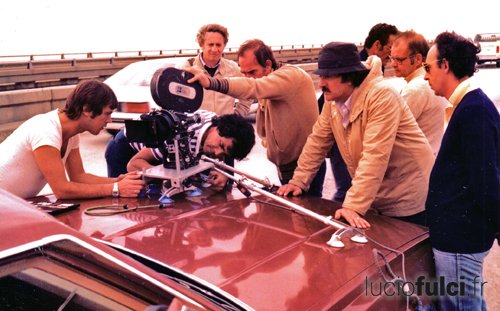
Lucio Fulci (right, wearing a light-colored sweater) oversees the staging of a shot on the Pontchartrain Causeway.
Was shooting with the dog difficult?
No. The hardest was to find a German shepherd identical to the one chosen for the scenes shot in Italy. The dog in the scenes shot in America was named Max. He was trained to sniff out explosives and belonged to the Jefferson Parish’s Sheriff. He was incredibly calm despite the whole distraction and noise of the shooting and got on really well with Cinzia Monreale.
But what was in Fulci’s mind in filming that scene?
When you are on this bridge, you do not see the end of it. I think that for Fulci, this causeway in the middle of water went off symbolically into the Beyond.
So, you ended up getting the Pontchartrain Causeway shut down. But how did you manage to make the French Quarter appear to be deserted?
It cost us a lot in cold, ready cash. We hired a Police detail to block off and close the two main streets through the neighbourhood we were using in order to have one street for the technical side and electrical generator trucks and the rest for the shooting itself. We had to go door to door ahead of time to explain what we were doing. In the beginning some of the residents weren’t interested and told us to “go away’. But they eventually came around when we offered them cash in hand. We had to use persuasion and psychology.
How did you end up playing the painter Larry?
Hahanah ! It was very simple. After working with them for a while, one day, they came to and asked me if I wanted to be in a little scene – David knew that I had acted for years in a theatrical troupe and had done small parts in movies. I learned, “the little scene” involved my falling from an 8 meter scaffolding platform into a ‘bust bag’ which is used for stunt falls. It is a large bag that rapidly deflates when you land on it. But you have to land in on the “X” in the middle of it ! But the hardest was shooting the cut-in s”hot in which I actually hit the ground. I had to jump from the third step of a ladder for several takes, biting a blood capsule at just the right time so the “blood” would run out of the corner of my mouth.
I am also in the scene with the spiders. There were some real ones mixed in it as with some electrically operated very realistic looking fake ones. When Michele Mirabella, the guy who plays the architect , saw the real ones coming out of their boxes, he categorically refused to shoot the close ups and refused to be near them. Then I was asked : “ Hey Larry, are you afraid of spiders ?”. I said that I was not and Maurizio Trani, this wonderful make up artist, applied this fake three days beard on me. That’s how it happened. I had lots of fun shooting that scene in which is cropped from my nose down to my chest with spiders crawling up to on my chin. Incidentally, there were special spider ‘handlers’ who were able to make the live tarantulas turn right or left as they crawled up toward my face by blowing on them through long straws just out of camera range.
But wasn’t this scene shot in Italy?
Yes, yes. After the shooting in the US, I went to Italy for two weeks and visited the Italian shoot. It was in the Biblioteca della Società Geografica Italiana in January I think. It was very cold in there and they had to use the hot lights held right over the cold marble floors to warm them up enough so the spiders would crawl over them.
You are credited under the following name : Anthony Flees. Why this pseudonym?
I had nothing to do with it. I think the credit names were just made up (except for the principal actors) after L’Aldila was sold at MIFED, you know the international film market in Milan. They needed names and if didn’t know the actor’s actual names in the smaller parts they just made them up. Before Anthony Flees, in earlier VHS releases they used another made up name, Eric Farber for the role of Larry! There was no regulation or control for proper listing of cast names at all for those kinds of movies.
How did Lucio Fulci direct the English speaking actors as his own command of the language was at best limited?
David Pash was bilingual and therefore present at all rehearsals and takes. Often Fulci directed by miming, making faces and moving his body in order to make the actors understand what he wanted of them. There often was not much actual talking involved after rehearsals and read-throughs. For example, Fulci stood behind the hotel window in the scene in which I see the eyes which startle me, causing me to jump back and fall off the painter’s scaffolding. I had to convey terror. We did several takes of this scene as Fulci shouted “No, no ! More, more !”
How did shooting go with David Warbeck and Catriona Mac Coll?
They were consummate professionals, so there were few problems and they never complained. We all had a good time despite a very tight schedule. As for the US shooting, I was never aware of friction or problems between the actors or with Fulci. David Warbeck loved New Orleans and enjoyed his free nights exploring and partying in the French Quarter.
You said that many scenes were found/created during the production. Was the screenwriter Dardano Sacchetti present during the shooting for the rewritings?
No, I have no recollection of this person. Apart from his name being credited for the brief script outline, I do not remember his being his involved in production. At least for during US shooting.
The photographs in this interview are from Larry Ray’s personal collection.

Larry Ray – acteur/assistant production (L’Au-delà)
L’Au-delà est sans conteste le film le plus connu de Lucio Fulci, le plus apprécié. Nombre d’images iconiques en est extrait : le lynchage du peintre, le mystérieux symbole, Emily sur le Pontchartrain Causeway vide ou encore le final à la beauté éternelle. Ainsi, le film a fait l’objet de multiples analyses et surinterprétations. Son tournage a même été raconté parfois par Fulci lui-même mais aussi par sa squadra ou ses acteurs depuis une dizaine d’années. Mais jusqu’à présent, le point de vue américain sur la fabrication du film a souvent été négligé. Voici donc un entretien avec Larry Ray, un journaliste et acteur américain qui s’est retrouvé assistant du producteur lors du tournage aux Etats-Unis après avoir été le traducteur lors des premiers repérages à la Nouvelle-Orléans…
Comment avez-vous intégré l’équipe de tournage de L’Au-delà ?
Je venais de mettre fin à 20 ans de journalisme télé et de production, et m’apprêtais à créer ma société de production vidéo, TELEventure. J’étais donc libre. C’est à ce moment-là que Jo Beth Bolton, la Présidente de la Louisiana State Film Commission, m’a appelé parce qu’une production italienne faisait des repérages dans la région. Or, personne de l’équipe ne maîtrisait l’anglais. Comme je suis bilingue et que je connais bien la Louisiane, elle a pensé à moi. J’ai d’abord rencontré le producteur, Fabrizio De Angelis, un véritable gentleman, puis j’ai aidé Sergio Salvati et Lucio Fulci à trouver les lieux de tournage. J’ai accompli cette mission sans lire une ligne du scénario d’ailleurs.
Nous nous sommes très bien entendus, ils m’ont apprécié et m’ont demandé de travailler à plein temps sur le film aux USA.
A quel poste ?
Je suis devenu l’assistant du producteur. Je m’occupais de toutes les choses possibles et imaginables. Je trouvais des figurants, gérait l’argent qui venait d’Italie, servait de traducteur auprès des autorités locales, etc. Il faut dire que le budget était minuscule… Comme tout producteur qui se respecte, De Angelis était un jongleur. Je travaillais aussi en étroite collaboration avec David Pash, le directeur de production, un type formidable.
Quels étaient les différents lieux de tournage ?
Les acteurs et toute l’équipe logeaient à l’International Hotel qui se trouvait sur Canal Street, en centre-ville de la Nouvelle-Orléans. Le très joli hôtel appartenait à des fils d’Italiens qui avaient immigré de la Sicile à la Nouvelle-Orléans. Les nouveaux membres de l’équipe qui restaient pour un ou deux jours dormaient aussi là-bas.
Le tournage des extérieurs jour et nuit à la Nouvelle-Orléans avaient lieu dans le French Quarter, également appelé le Vieux Carré. Nous avons aussi tourné sur Orange Street dans une partie historique de la ville pour la scène de la maison barricadée ainsi que sur le campus de l’Université Dillard. Nous y avons utilisé le bâtiment principal de l’administration avec ses colonnes larges et longues pour l’extérieur de l’hôpital où Warbeck se rend avec précipitation. En face du French Quarter, nous avons tourné dans le cimetière historique Saint Louis Number One. Parce que la ville, et plus particulièrement le Vieux Carré est construite sur un sol marécageux, les cercueils ressurgissent à la surface après une grosse pluie. Alors, tout enterrement se fait sur terre dans des caveaux en briques. Nous avons engagé le jeune prêtre d’une église catholique du coin pour la scène des obsèques.
Et l’hôtel ?
Alors, le tournage s’est ensuite déplacé à Lake Pontchartrain, à côté de Madisonville en Louisiane, dans le Fairview Riverside State Park où se trouve la Otis House. Cela veut dire que les acteurs et l’équipe technique faisaient plus de 77 km par jour pour venir travailler depuis la Nouvelle-Orléans. Il y avait quatre ou cinq vans pour le transport. J’ai embauché les traiteurs pour le tournage en centre-ville et d’autres lorsque nous étions dans la Otis House.
On connaît l’équipe italienne du film. Mais qu’y avait-il parmi les américains ?
Joe Catalanotto, un producteur indépendant de la Nouvelle-Orléans, a été embauché au dernier moment après l’annulation soudaine du film sur lequel il devait travailler. C’était un petit film d’horreur dont le titre devait être The Scream. Nous avons eu la possibilité de l’avoir avec son équipe, ce qui était génial pour lui et son équipe, mais aussi pour Fulvia Film. Joe était une légende et possédait une gamme assez large de fourgons, de lumières, de générateurs et tout le matériel nécessaire pour le tournage. « Little Joe » était déjà bien installé et reconnu sur la Côte Ouest et à New York pas seulement pour son matériel de production et son personnel bien formé mais aussi pour son travail avec des équipes de production réduites. C’était un homme plein d’énergie et tout le temps occupé. Les Italiens l’aimaient parce qu’il venait d’une famille italienne et avait un grand sens de l’humour en plus d’être un professionnel expérimenté. Il savait trouver de l’électricité n’importe où, même dans des conditions parfois dangereuses.
J’imagine que vous ne connaissiez pas Lucio Fulci avant de travailler sur L’Au-delà. Quelle a été votre relation avec lui ?
En effet, je ne le connaissais pas. Je dois dire que j’ai passé de très bons moments avec lui. Cependant, il était assez mystérieux, lunatique.
C’est-à-dire ?
Il pouvait crier sur le tournage mais il savait jusqu’où il pouvait aller parce qu’il connaissait bien son équipe. Ils avaient déjà fait plusieurs films ensemble. Fulci avait besoin de marquer son territoire. Je me rappelle que pour la scène dans la maison barricadée, il avait fait une crise parce qu’il voulait une glace. Nous avons envoyé quelqu’un en acheter une. La lumière était prête, les acteurs aussi, mais Fulci ne voulait pas tourner tant qu’il n’avait pas sa glace. Le maquillage commençait à couler dans la chaleur humide de la Nouvelle-Orléans. Sa glace arrivée, il a engueulé la personne pour le retard ! En fait, Fulci était comme un enfant, il aimait crier tout le temps « Action ! Action ! » et quand une idée lui passait par la tête, il disait « Hé ! Essayons ça ! »
Sur le plan artistique justement, ça se passait comment ?
Le scénario ne faisait que trois pages avec une histoire un peu différente du film. Fulci trouvait toujours de nouvelles idées. Je vous donne un exemple. A 100 mètres de la Otis House qu’on a utilisé pour l’hôtel du film, il y avait un lac long et étroit. On nous avait donné l’autorisation de tourner les extérieurs et les intérieurs de cette maison historique. Lucio Fulci ou Sergio Salvati a eu l’idée d’utiliser la petite partie du lac avec des pirogues pleines d’hommes en colère tenant des torches. Cela a donné de très beaux reflets sur l’eau et des générateurs de fumée ont donné une atmosphère parfaite. Alors, beaucoup de ces scènes ont été pensées et ajoutées dans un travail collectif entre Lucio, David Pash et l’équipe de tournage.
Cette séquence a donc été tournée aux Etats-Unis ?
Oui, pour une partie, le reste a été tourné à Rome. J’ai trouvé toutes les personnes pour jouer les villageois. David Pash joue le meneur de la bande qui a une torche dans la main et qui mène la foule dans l’hôtel jusque dans les escaliers. Les plans où la foule se précipite à l’intérieur, monte les escaliers jusqu’au moment où elle se trouve devant la porte avant d’attaquer le peintre pour le torturer, c’est le tournage américain. Puis, le reste de la scène où ils surgissent dans la chambre a été tourné en Italie avec des acteurs différents des corpulences similaires et portant les mêmes costumes. L’action est homogène. Le vieux réceptionniste noir qui transpire et qui regarde les hommes entrer dans l’hôtel impuissamment s’appelait Johnny Burton je crois. Il vivait dans une petite maison sur la route qui menait au parc. C’est là qu’on a vu son vieil utilitaire déglingué. On lui a loué pour la scène où le plombier arrive à l’hôtel avec sa caisse à outils. Je crois que l’idée de lui faire jouer ce petit rôle venait de David Pash.
Pour info, les deux vieilles voitures qui arrivent devant l’hôtel ont aussi été utilisées dans La Petite (Pretty Baby, 1978) de Louis Malle.
Mais la maison qui a été transformée en hôtel pour le film n’était pas si délabrée, si ?
Otis House est une demeure historique avec un très beau plancher bois et des meubles d’origine hors de prix. Les Italiens ont voulu la vieilir. Pour cela, ils l’ont aspergée d’eau colorée. Jusque là, rien de grave avec ce procédé pour « vieillir » la maison. Mais pour une raison que j’ignore, ils ont jeté du ciment sec et du sable sur le sol de la maison, ce qui l’a rongé et rayé. Or, c’étais moi le responsable auprès des officiels de State Park parce que j’avais aidé l’équipe à obtenir l’autorisation. Il faut dire qu’elle appartient à l’Etat de Louisiane. Ils sont devenus fous quand ils ont vu l’état dans lequel les Italiens ont laissé la demeure. Fabrizio m’a finalement donné de l’argent pour que je m’occupe de la restauration du lieu.
Comment est née la scène sur le Pontchartrain Causeway ? Elle n’était pas dans le scénario non plus…
Exactement. En fait, chaque jour, comme je vous l’ai déjà dit, l’équipe faisait des allers-retours sur ce pont entre la Nouvelle-Orléans et les lieux du tournage. Les 77 km quotidiens de pont ont dû le travailler car un jour il est arrivé avec l’idée d’y tourner une scène. Bloquer les deux voies du pont semblait impossible, même pour deux heures, mais c’est ce que voulait Fulci. Je me suis rendu à la commission qui gère le pont accompagné de Fulci bien entendu. Je crois qu’il y avait aussi Salvati, De Angelis et Cinzia Monreale, la fille qui joue l’aveugle donc. Fulci avait un anglais très approximatif alors j’ai parlé pour eux. J’ai présenté le film comme une production importante tournée par le Hitchock italien et dont la scène sur le Pontchartrain Causeway est le point central du film. Je connaissais un des membres de la commission, Bobby Ragsdale. Il aimait ce que j’avais fait à la télévision et dans une filiale de CBS. C’est pour cela que nous avons eu l’autorisation de bloquer un côté du pont… pour un peu plus de deux heures !
Nous avons fait en sorte de tourner tous les plans dont nous avions besoin à temps. Puis avant de tout remballer, Fulci a demandé qu’on place la chaise du réalisateur au milieu du pont totalement vide qui s’étendait vers l’horizon. Fulci s’est assis dedans et a eu droit à plusieurs photos couleur puis le pont a pu être rouvert au trafic qui attendait !

Lucio Fulci (sur la droite avec le pull clair) surveille la préparation d’un plan sur le Pontchartrain Causeway.
Et tourner avec le chien, cela a-t-il été difficile ?
Non. Le plus difficile a été de trouver un berger allemand identique à celui choisi pour les scènes tournées en Italie. Le chien qui joue dans les plans au Etats-Unis s’appelait Max. Il était entraîné pour renifler les explosifs et appartenait au Shérif de Jefferson Parish. Il est resté d’un calme exemplaire malgré l’agitation du tournage et s’est très bien entendu avec Cinzia Monreale.
Mais quelle était l’idée de Fulci en filmant cette scène ?
Quand on est sur ce pont, on n’en voit pas la fin. Je pense que pour Fulci, cette chaussée au milieu de l’eau mène symboliquement vers l’au-delà.
Alors, vous avez eu le Pontchartrain Causeway vide. Comment avez-vous fait pour filmer le French Quarter complètement désert ?
Ça nous a coûté cher en argent liquide pour l’obtenir. Il a fallu le concours de la police pour barrer les deux rues principales du quartier afin d’avoir une rue pour l’installation technique et les camions qui servait de groupes électrogènes et le reste pour le tournage. On a dû frapper à la porte des habitants en avance pour leur expliquer ce que nous faisions. Au début, certains résidents n’étaient pas intéressés et nous disaient : « Foutez le camp ! » Puis ils se ravisaient quand on leur proposait de l’argent en liquide. Il a fallu être très psychologue.
Comment vous êtes-vous retrouvé à jouer le peintre Larry ?
Ahahah ! C’est très simple. Ça faisait quelques temps que je travaillais avec eux et un jour, ils sont venus me demander si je voulais jouer dans une petite scène – David savait que j’avais joué pendant des années dans une troupe de théâtre et que j’avais eu des petits rôles dans des films. J’ai appris que ma « petite scène » consistait à sauter de 8 mètres depuis un échafaudage sur un matelas « éclaté » utilisé pour les cascades. C’est un matelas large qui se dégonfle rapidement dès qu’on atterrit dessus. Mais il faut sauter sur le X au milieu du matelas ! Mais le plus difficile a été de tourner le plan où j’heurte le sol. J’ai dû sauter de la troisième marche d’un escabeau à plusieurs reprises, tout en cassant une capsule de sang au bon moment pour que le « sang » sorte du coin de ma bouche.
Je joue aussi dans la scène des araignées. Dans cette scène, il y en avait des vraies mélangées avec des fausses assez réalistes qui fonctionnaient électroniquement. Quand Michele Mirabella, celui qui joue l’architecte, a vu les vraies sortir de leur boîte, il a refusé catégoriquement de tourner les gros plans et ne souhaitaient pas non plus les avoir à proximité. On m’a alors dit : « Hé Larry, tu as peur des araignées ? » J’ai répondu que non et Maurizio Trani, ce merveilleux maquilleur, m’a mis cette barbe de trois jours. C’est comme ça que c’est arrivé. Cela m’a beaucoup amusé de tourner ce plan où on voit de mon nez à ma poitrine avec les araignées rampant jusqu’à mon menton. A propos, il y avait des « dresseurs » d’araignées spéciaux qui savaient faire tourner les tarentules à droite ou à gauche quand elles grimpaient sur mon visage en soufflant dans de longues pailles hors champ.
Mais cette scène n’a pas été tournée en Italie ?
Si, si. Après le tournage aux Etats-Unis, je suis allé deux semaines en Italie et suis donc passé sur le tournage. C’était à la Biblioteca della Società Geografica Italiana au mois de janvier je crois. Il faisait tellement froid à l’intérieur qu’ils ont réchauffé le sol marbré des lumières chaudes pour que les araignées puissent se déplacer dessus.
Vous êtes crédité sous le nom suivant : Anthony Flees. D’où vient ce pseudonyme ?
J’y suis totalement étranger. Je crois que les noms étaient simplement inventés (à part pour les acteurs principaux) après la vente de L’Au-delà au MIFED, vous savez, le marché international du film à Milan. Ils avaient besoin de noms et s’ils ne connaissaient pas les vrais noms des acteurs secondaires, ils les inventaient. Avant Anthony Flees, dans les premières sorties VHS, ils ont utilisé un autre nom, Eric Farber pour le rôle de Larry ! Il n’y avait pas de règle ni de contrôle pour ces films-là.
Comment Lucio Fulci dirigeait-il les acteurs anglophones puisque son Anglais était approximatif ?
David Pash était bilingue et, par conséquent, il était présent à toutes les lectures, répétitions et prises. Souvent, Fulci dirigeait en mimant, en faisant des grimaces et en faisant des mouvements avec son corps pour indiquer le genre d’expression qu’il souhaitait. Ça ne nécessitait pas beaucoup de parler après les répétitions et les lectures. Par exemple, Fulci était derrière la fenêtre de l’hôtel dans la scène où je vois les yeux qui me surprennent, provoquant ainsi ma chute de l’échafaudage du peintre. Je devais exprimer la terreur. Nous avons fait plusieurs prises de ce plan parce que Fulci criait tout le temps en agitant ses mains : « Non, non ! PLUS, PLUS ! »
Comment s’est passé le tournage avec David Warbeck et Catriona MacColl ?
C’étaient des acteurs très professionnels, alors il n’y avait pas beaucoup de problèmes et ils ne se plaignaient jamais. Nous avons tous passé un bon moment malgré un planning de travail serré. Pour ce qui concerne le tournage aux Etats-Unis, je n’ai pas été au courant de frictions ou de problèmes entre les acteurs et Fulci, ou qui que ce soit d’autre. David Warbeck a beaucoup aimé la Nouvelle-Orléans et a apprécié explorer et faire la fête durant ses nuits libres au French Quarter.
Vous avez dit que de nombreuses scènes ont été « trouvées » durant la production. Est-ce que le scénariste Dardano Sacchetti était sur le tournage pour les réécritures ?
Non, je n’ai aucun souvenir de ce monsieur. A part son nom sur le scénario minuscule qui servait de base au tournage, je ne me rappelle pas d’une implication de sa part dans la production. Du moins, pendant le tournage américain.
Les photos publiées dans cet entretien proviennent de la collection personnelle de Larry Ray.
Remerciement spécial à Marija Nielsen.

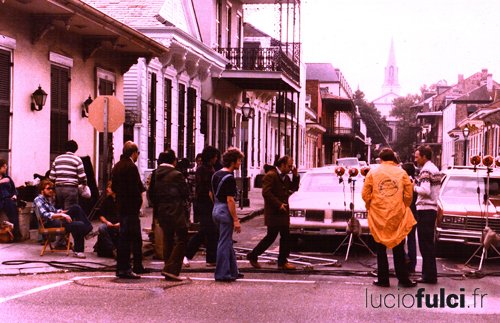
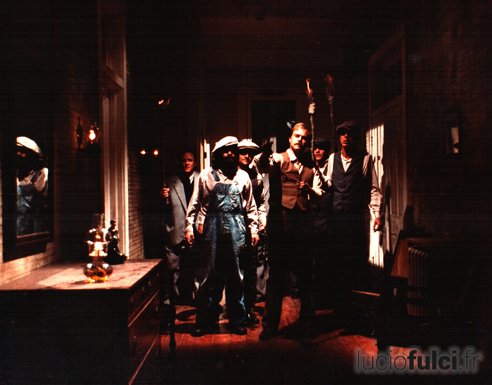
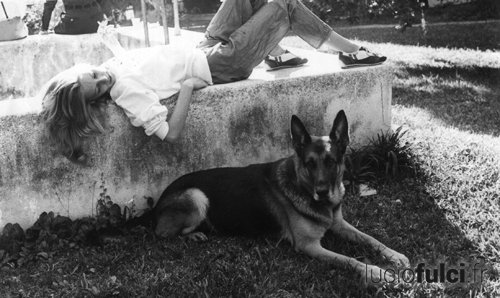
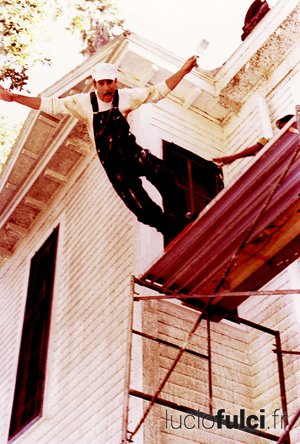
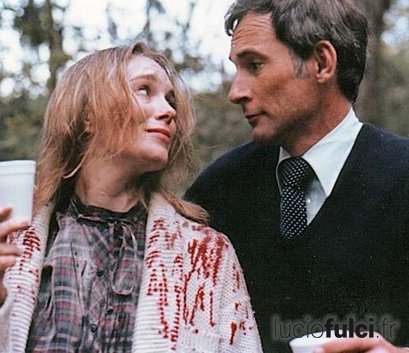
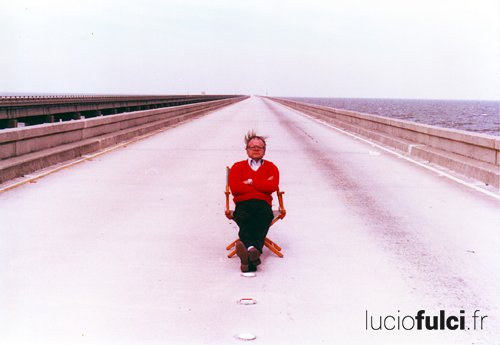

Laisser un commentaire